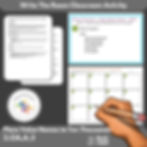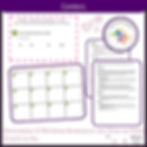Hey there! You know how crucial first grade is for setting the foundation in writing, right? Let’s chat about some essential first grade writing IEP goals we can set to help our little ones grasp grammar and mechanics. We’ll go through capitalization, punctuation, complete sentences, and all those grammar goodies step-by-step. Ready? Let’s dive in!

What You Will Learn
In this blog article, we'll explore:
Capitalization
Days, Months, and Sentences
Punctuation
Complete Sentences
Nouns
Pronouns
Choosing the Correct Possessive Pronoun
Verbs and Subject-Verb Agreement
Using Action Verbs
Verb Tenses
Adjectives
Prepositions
Linking Words
Contractions
We'll provide IEP goals, objectives, worksheet examples, and common student misconceptions for each topic.
Capitalization: Starting Big!
Capitalization is one of the first writing skills we tackle with our first graders. It’s amazing how quickly kids pick this up once they understand the basics.
IEP Goal:
The student will correctly capitalize the first letter of names, days, months, and the pronoun "I" in sentences with 80% accuracy in 4 out of 5 opportunities.
Objectives:
The student will capitalize the first letter of names of people and pets in 4 out of 5 opportunities.
The student will capitalize the first letter of days and months in 4 out of 5 opportunities.
The student will correctly capitalize the first letter of each sentence and the pronoun "I" in 4 out of 5 sentences.
Worksheet Example
Sentence | Corrected Sentence |
my dog max and i went to the park. | My dog Max and I went to the park. |
today is tuesday. | Today is Tuesday. |
we visited aunt sue in july. | We visited Aunt Sue in July. |
Common Misconceptions:
Students often forget to capitalize the pronoun "I."
They may not realize that days and months need capitalization.
Some students might capitalize random words in the middle of sentences.
Days, Months, and Sentences
Next up, days and months. This one’s fun because we can tie it into our calendar activities.
IEP Goal:
The student will correctly capitalize days and months in sentences with 80% accuracy in 4 out of 5 opportunities.
Objectives:
The student will write the day’s date with correct capitalization in 4 out of 5 opportunities.
The student will write the month with correct capitalization in 4 out of 5 opportunities.
Worksheet Example
Date | Corrected Date |
today is monday. | Today is Monday. |
tomorrow is december 1st. | Tomorrow is December 1st. |
i was born on a friday. | I was born on a Friday. |
Common Misconceptions:
Students might write days and months with lowercase letters.
They may confuse the correct capitalization for days of the week and months of the year.
Punctuation: Ending with Style
Now, punctuation. It’s so important for them to understand the different types of sentences.
IEP Goal:
The student will correctly use punctuation marks to end statements, questions, exclamations, and commands with 80% accuracy in 4 out of 5 opportunities.
Objectives:
The student will identify statements and end them with a period in 4 out of 5 opportunities.
The student will identify questions and end them with a question mark in 4 out of 5 opportunities.
The student will identify exclamations and end them with an exclamation mark in 4 out of 5 opportunities.
The student will identify commands and end them with the appropriate punctuation mark in 4 out of 5 opportunities.
Worksheet Example
Sentence | Correct Punctuation |
do you like ice cream | Do you like ice cream? |
i have a new puppy | I have a new puppy. |
wow, that’s amazing | Wow, that’s amazing! |
Common Misconceptions:
Students might use a period at the end of questions.
They may not recognize when to use an exclamation mark.
Some might overuse exclamation marks in inappropriate places.
Complete Sentences: Making Sense
Complete sentences are next. We want them to understand that every sentence needs a subject and a verb.
IEP Goal:
The student will write complete sentences with a subject and a verb with 80% accuracy in 4 out of 5 opportunities.
Objectives:
The student will identify the subject and verb in given sentences in 4 out of 5 opportunities.
The student will write a sentence with both a subject and a verb in 4 out of 5 opportunities.
Worksheet Example
Picture | Sentence |
|---|---|
A picture of a dog playing | The dog likes to play. |
A picture of a girl reading | The girl reads a book. |
A picture of a boy running | The boy runs fast. |
Common Misconceptions:
Students might write fragments that lack either a subject or a verb.
They might write run-on sentences by stringing together multiple thoughts without punctuation.
Nouns: People, Places, and Things
Nouns are foundational. We start with identifying common nouns and then move to proper nouns.
IEP Goal:
The student will correctly identify and use common and proper nouns in sentences with 80% accuracy in 4 out of 5 opportunities.
Objectives:
The student will identify common nouns in 4 out of 5 opportunities.
The student will identify proper nouns in 4 out of 5 opportunities.
The student will use common and proper nouns correctly in sentences in 4 out of 5 opportunities.
Worksheet Example
Common Nouns | Proper Nouns |
The girl | Emma |
The city | New York |
The river | Mississippi River |
Common Misconceptions:
Students might capitalize common nouns thinking they are proper nouns.
They may confuse common nouns with proper nouns.
Pronouns: Replacing Nouns
Once they grasp nouns, we introduce pronouns to replace them.
IEP Goal:
The student will correctly use pronouns to replace nouns in sentences with 80% accuracy in 4 out of 5 opportunities.
Objectives:
The student will replace nouns with appropriate pronouns in 4 out of 5 opportunities.
The student will use subject and object pronouns correctly in sentences in 4 out of 5 opportunities.
Worksheet Example
Sentence | Corrected Sentence |
Emma likes Emma’s dog. | Emma likes her dog. |
The boy lost the boy’s hat. | The boy lost his hat. |
Sally and Tom went to Sally and Tom’s house. | Sally and Tom went to their house. |
Common Misconceptions:
Students might use the wrong pronoun for the subject or object of a sentence.
They may confuse possessive pronouns with subject pronouns.
Choosing the Correct Possessive Pronoun
Understanding and using possessive pronouns correctly helps students make their writing clearer.
IEP Goal:
The student will correctly use possessive pronouns in sentences with 80% accuracy in 4 out of 5 opportunities.
Objectives:
The student will identify possessive pronouns in 4 out of 5 opportunities.
The student will correctly use possessive pronouns in their writing in 4 out of 5 opportunities.
Worksheet Example
Sentence | Corrected Sentence |
The cat washed the cat's paws. | The cat washed its paws. |
This is Sarah’s book. It is Sarah’s. | This is Sarah’s book. It is hers. |
The children forgot the children’s toys. | The children forgot their toys. |
Common Misconceptions:
Students might use possessive pronouns incorrectly, confusing them with other types of pronouns.
They may forget to change the pronoun to match the noun's possession.
Verbs and Subject-Verb Agreement
Verbs are action words, and we pair them with subjects to teach subject-verb agreement.
IEP Goal:
The student will correctly use verbs and maintain subject-verb agreement in sentences with 80% accuracy in 4 out of 5 opportunities.
Objectives:
The student will identify verbs in sentences in 4 out of 5 opportunities.
The student will ensure subject-verb agreement in their writing in 4 out of 5 opportunities.
Worksheet Example
Sentence | Corrected Sentence |
The cat run. | The cat runs. |
The dogs barks. | The dogs bark. |
She like pizza. | She likes pizza. |
Common Misconceptions:
Students might use the incorrect verb form that doesn’t agree with the subject.
They may confuse singular and plural forms of verbs.
Using Action Verbs
Action verbs bring sentences to life. We introduce words like fall, run, hop, fly, grow, and more.
IEP Goal:
The student will correctly use action verbs in sentences with 80% accuracy in 4 out of 5 opportunities.
Objectives:
The student will identify action verbs in sentences in 4 out of 5 opportunities.
The student will use action verbs correctly in their writing in 4 out of 5 opportunities.
Worksheet Example
Action Verb | Sentence |
run | The boy runs quickly. |
hop | The rabbit hops in the grass. |
fly | The bird flies high. |
Common Misconceptions:
Students might confuse action verbs with other types of verbs, such as linking verbs.
They may use incorrect forms of action verbs.
Verb Tenses: Time Travelers
Verb tenses are next, teaching past, present, and future.
IEP Goal:
The student will correctly use past, present, and future verb tenses in sentences with 80% accuracy in 4 out of 5 opportunities.
Objectives:
The student will identify past, present, and future tense verbs in 4 out of 5 opportunities.
The student will use the correct verb tense in their writing in 4 out of 5 opportunities.
Worksheet Example
Sentence (Present Tense) | Sentence (Past Tense) |
She walks to school. | She walked to school. |
They play soccer. | They played soccer. |
I eat breakfast. | I ate breakfast. |
Common Misconceptions:
Students might mix up past, present, and future tenses within the same sentence.
They may use the wrong tense for the context of the sentence.
Adjectives: Describing Words
Adjectives add flavor to sentences. We teach them to describe nouns.
IEP Goal:
The student will correctly use adjectives to describe nouns in sentences with 80% accuracy in 4 out of 5 opportunities.
Objectives:
The student will identify adjectives in sentences in 4 out of 5 opportunities.
The student will use adjectives to describe nouns in their writing in 4 out of 5 opportunities.
Worksheet Example
Sentence | Corrected Sentence |
The cat is. | The black cat is fluffy. |
The flower is. | The red flower is pretty. |
The car is. | The fast car is blue. |
Common Misconceptions:
Students might use adjectives incorrectly, placing them in the wrong part of the sentence.
They may confuse adjectives with other parts of speech, such as adverbs.
Prepositions: Showing Relationships
Prepositions show the relationship between nouns.
IEP Goal:
The student will correctly use prepositions to show the relationship between nouns in sentences with 80% accuracy in 4 out of 5 opportunities.
Objectives:
The student will identify prepositions in sentences in 4 out of 5 opportunities.
The student will use prepositions correctly in their writing in 4 out of 5 opportunities.
Worksheet Example
Sentence | Corrected Sentence |
The book is. | The book is on the table. |
The cat is. | The cat is under the chair. |
The picture is. | The picture is on the wall. |
Common Misconceptions:
Students might leave out prepositions, making the sentence unclear.
They may use the wrong preposition, confusing the relationship between the nouns.
Linking Words: Connecting Ideas
Linking words connect ideas in sentences.
IEP Goal:
The student will correctly use linking words to connect ideas in sentences with 80% accuracy in 4 out of 5 opportunities.
Objectives:
The student will identify linking words in sentences in 4 out of 5 opportunities.
The student will use linking words to connect ideas in their writing in 4 out of 5 opportunities.
Worksheet Example
Sentence | Corrected Sentence |
I like pizza. I like ice cream. | I like pizza and ice cream. |
She is tired. She finished her homework. | She is tired because she finished her homework. |
We went to the park. We played soccer. | We went to the park and played soccer. |
Common Misconceptions:
Students might use linking words incorrectly, causing run-on sentences.
They may use linking words repetitively, making sentences awkward.
Contractions: Short and Sweet
Finally, contractions. These make writing more natural.
IEP Goal:
The student will correctly use contractions in sentences with 80% accuracy in 4 out of 5 opportunities.
Objectives:
The student will identify contractions in sentences in 4 out of 5 opportunities.
The student will use contractions correctly in their writing in 4 out of 5 opportunities.
Worksheet Example
Full Phrase | Contraction |
I will go. | I’ll go. |
You are nice. | You’re nice. |
They are happy. | They’re happy. |
Common Misconceptions:
Students might confuse contractions with possessive forms (e.g., "its" vs. "it’s").
They may leave out the apostrophe in contractions.
Wrapping Up
By setting these specific first grade writing IEP goals and using engaging, hands-on activities, we can help our first graders build a strong foundation in writing. Remember, the key is to make learning fun and relatable. These writing IEP goals for first grade cover all the essential elements, from capitalization to contractions, ensuring comprehensive development. Happy teaching as you work on writing goals for first grade IEP students!
































